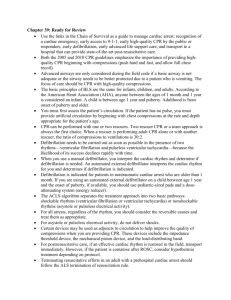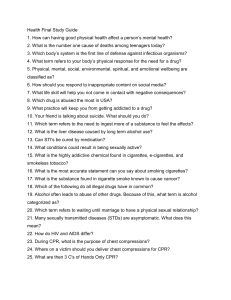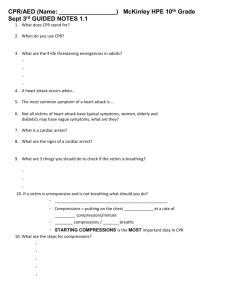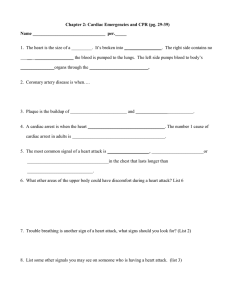Mock Code Preparation: CPR, Defibrillation, & Cardiac Arrest
advertisement
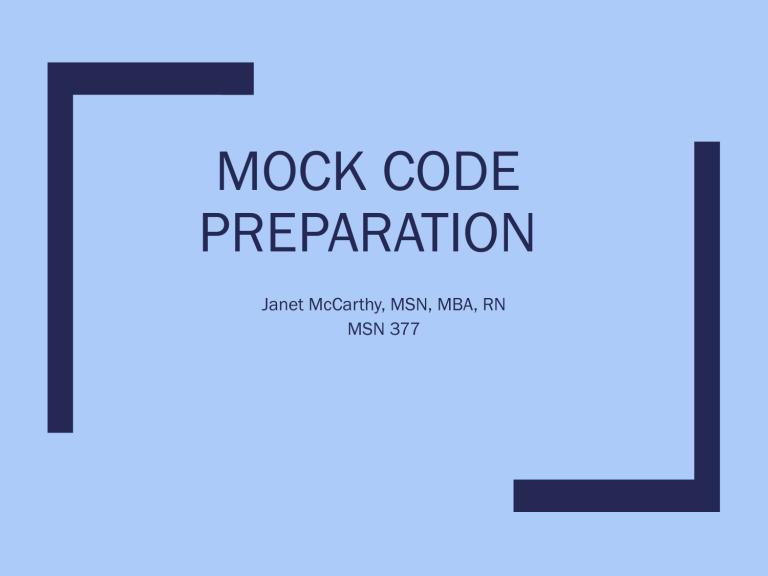
MOCK CODE PREPARATION Janet McCarthy, MSN, MBA, RN MSN 377 Early Identification and Treatment ■ Rapid response teams – or early medical emergency teams – Documented reductions in cardiac arrest – Improved patient outcomes Cardiac Arrest ■ Ventricular fibrillation (VF) --> defib, CPR ■ Ventricular tachycardia (Vtach) – pulseless defib ■ Pulseless electrical activity (PEA) rhythm tracing and no pulse ■ Asystole CPR ■ Primary – good CPR, early defib for VT & VF ■ Witnessed arrest: – Check for pulse – if no pulse, – Begin CPR ■ Continue cycles of 30 compressions/2 breaths ■ Check for pulse & rhythm every 5 cycles (2 minutes) ■ During early stages of CPR, chest compressions are more important than breaths ■ Do not provide excessive ventilation – increases intrathoracic pressure, decreases venous return ■ Use barrier device or bag/mask CPR- Key Points ■ Once intubated, ventilate at rate of 8-10 breaths/min – do not synchronize with chest compressions ■ Confirm placement of ETT – bilateral chest expansion, exhaled CO2, auscultation, CXR ■ Chest compressions at 100/minute (hard & fast!) ■ Depress sternum 1.5 to 2 inches - allow chest to recoil after each compression ■ Risk of gastric inflation if breaths given too forcefully ■ Compressor should be relieved every 2 minutes to avoid fatigue (& less effective compressions) ■ No longer than 10 seconds to check for pulse ■ Avoid compression interruptions (e.g. IV insertion) Defibrillation - Key Points ■ Goal of defibrillation: reset electrical conduction system by depolarizing a critical mass of myocardial cells ■ Defibrillation (unsynchronized shock): Ventricular fibrillation (VF) & pulseless Ventricular tachycardia (VT) ■ Cardioversion (synchronized shock): used for Vtach with pulse & other arrhythmias (e.g. Afib) Defibrillation ■ First Defibrillation: – 120 – 150 - 200J for biphasic defibrillator – 200 – 300- 360J for monophasic defibrillator – If unknown, shock at 200J ■ Continue CPR while defibrillator charges ■ After shock - 5 cycles of CPR beginning with compressions ■ Check rhythm & pulse after 5 cycles CPR Cardiac Arrest - Key Points ■ IV access (central line allows faster circulation of drug) ■ If unable to get IV access, may use intraosseous (into marrow of long bones) ■ Last resort: endotracheal administration - administer 2 – 2.5 times the amount of drug ■ Follow peripheral drug administration with bolus of about 20 cc of IV fluid & elevate extremity ■ Administration of epinephrine (1 mg) may improve effectiveness of defibrillation (repeat q 3-5 minutes) ■ Use of vasopressin (40U) may or may not be helpful ■ Administer drugs ASAP after rhythm check Cardiac Arrest - Medical Management ■ If VF or pulseless VT persists after 2-3 shocks plus vasopressor (epinephrine or vasopressin), consider antiarrhythmic: amiodarone ■ Amiodarone suppress ventricular irritability – 150 - 300mg IV once, then 150mg ■ Consider Magnesium for torsades (polymorphic) de pointes – IV mag Asystole and PEA ■ Pulseless Electrical Activity – electrical activity present without palpable pulse, poor survival rate ■ Survival rate very poor for asystole 9cant shock, cpr or drugs) ■ Check asystole in 2 leads – may be fine VF ■ Defibrillation offers no benefit ■ Focus on good CPR ■ May administer vasopressor (epi or vasopressin) Look for possible causes… H’s (6): ■ Hypovolemia ■ Hypoxia ■ Hydrogen ion (acidosis) ■ Hypo- or hyperkalemia ■ Hypoglycemia ■ Hypothermia T’s (6): Toxins Tamponade (cardiac) Tension pneumo Thrombosis - coronary Thrombosis - pulmonary Trauma Interventions not supported by research ■ Pacing for asystole ■ Procainamide for VF or pulseless VT – can infiltrate veins ■ Norepinephrine (during arrest) ■ Precordial thump – vtach, vfib ■ Administration of electrolytes (except for magnesium for torsades de pointes) ■ Routine IV fluids Meds for Cardiovascular Support ■ Used to support cardiac output – Improve heart rate (chronotropic) – Improve myocardial contractility (inotropic) – Improve arterial pressure (vasoconstrictive) – Reduce afterload (vasodilation) ■ Many adrenergic drugs are not selective – May increase or decrease HR & afterload – May induce arrhythmias – May increase myocardial O2 demand Meds for Cardiovascular Support ■ Epinephrine (Adrenalin) – increases perfusion to brain & coronaries during CPR ■ Vasopressin (Pitressin) – may cause coronary & renal vasoconstriction ■ Norepinephrine (Levophed) – inotrope & potent vasoconstrictor; used for severe hypotension; central line (extravasation) ■ Dopamine (Intropin) – dose dependent effects: – .5-2 mcg/kg/min: dopaminergic (renal perfusion) – 2-10 mcg/kg/min: inotropic – >10mcg/kg/min: vasoconstriction Additional Meds ■ Dobutamine (Dobutrex) – synthetic catecholamine & potent inotrope; severe systolic heart failure ■ Inamrinone – inotropic, vasodilator of vascular smooth muscle; heart failure ■ Calcium – for hypocalcemia, calcium channel blocker toxicity ■ Digitalis – inotrope: afib, aflutter ■ Nitroglycerin – relaxes vascular smooth muscle; CHF, HTN ■ Nitroprusside (Nipride) - potent peripheral vasodilator; HTN Research ■ Hypothermia therapy – Current guidelines recommend cooling to 32-34C for patients in a coma after cardiac arrest from VF – Cardio- and neuro- protective effects – Cool by large volume ice cold IV fluids, cooling blankets ■ Coenzyme Q10– Neuroprotectant – improve neurological outcome?? Ethics All patients should be provided CPR except: ■ The patient has a valid Do Not Attempt Resuscitation (DNAR) order ■ The patient has signs of irreversible death (e.g. rigor mortis, decapitation, decomposition) ■ No physiological benefit can be expected because vital functions have deteriorated despite maximal therapy (e.g. progressive septic or cardiogenic shock) Withdrawal of Life Support ■ A recent meta-analysis of 11 studies involving 1,914 patients documented 5 clinical signs that were found to strongly predict death or poor neurological outcome, with 4 of the 5 predictors detectable at 24 to 72 hours after resuscitation: – Absent corneal reflex at 24 hours – Absent pupillary response at 24 hours – Absent pain withdrawal response at 24 hours – No motor response at 24 hours – No motor response at 72 hours Emotional Support of Family ■ Should family members be allowed to remain in room during code?

